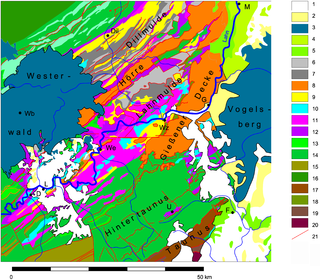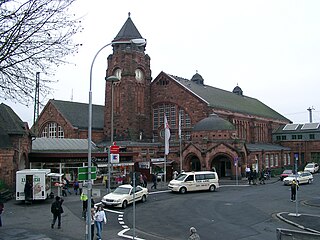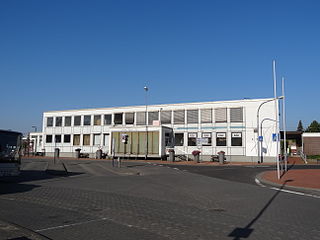
Dutenhofen is the eastmost borough of the city of Wetzlar, Germany. It has approximately 3,100 residents (December 31, 2005). [1]

Dutenhofen is the eastmost borough of the city of Wetzlar, Germany. It has approximately 3,100 residents (December 31, 2005). [1]
The district lies in the Lahntal region just south of the Lahn. Nearby is the Dutenhofener See, a lake featuring a man-made beach, volleyball pit, trampolines, cafe, and bar. East of the district lies the OCULUS GmbH industrial park.
Dutenhofen was an independent municipality until January 1, 1976, when it became a suburb of the city of Lahn. On August 1, 1979, Dutenhofen became a borough of Wetzlar. [1]
Dutenhofen is the home of the Handball-Club HSG Dutenhofen-Münchholzhausen , from Bundesligist HSG Wetzlar.
Dutenhofen shares busline 11 with the surrounding cities, including Giessen. Directly north of this borough runs the Bundesstraße B49 (Gießen - Wetzlar - Koblenz - Trier). Parallel to the road runs the Deutsche Bahn-line called "Dillstrecke" (Gießen - Wetzlar - Siegen).

Herborn is a historic town on the Dill in the Lahn-Dill district of Hesse in Germany. Before World War I, it was granted its own title as Nassauisches Rothenburg. The symbol or mascot of this town is a bear. Scenic attractions include its half-timbered houses; Herborn is located on the German Timber-Frame Road. Herborn hosted the 26th Hessentag state festival in 1986, and the 56th Hessentag in 2016.

Wetzlar is a city in the state of Hesse, Germany. It is the twelfth largest city in Hesse with currently 55,371 inhabitants at the beginning of 2019. As an important cultural, industrial and commercial center, the university town is one of the ten regional centers in the state of Hesse. A former free imperial city, it gained much of its fame as the seat of the Imperial Supreme Court (Reichskammergericht) of the Holy Roman Empire. Located 51 kilometers north of Frankfurt, at 8° 30′ E, 50° 34′ N, Wetzlar straddles the river Lahn and is on the German Timber-Frame Road, which passes mile upon mile of half-timbered houses. Historically, the city has acted as the hub of the Lahn-Dill-Kreis on the north edge of the Taunus. Tourists know the city for its ancient town and its medieval Catholic/Protestant shared cathedral of St. Mary. Notable architectural features include the Eisenmarkt and the steep gradients and tightly packed street layout of a medieval town. The building of the sandstone cathedral commenced in the 12th century in Romanesque style. In the later Middle Ages the construction continued under a master plan in Gothic style. The church was never finished—one steeple still remains uncompleted. The cathedral suffered heavy damage in the Second World War from aerial bombing, but restoration took place in the 1950s. On the outskirts of town along the river stand the ruins of several stone towers.
Giessen is a Kreis (district) in the middle of Hessen, Germany. Neighboring districts are Marburg-Biedenkopf, Vogelsbergkreis, Wetteraukreis, and Lahn-Dill.
Lahn-Dill is a Kreis (district) in the west of Hesse, Germany. Neighboring districts are Siegen-Wittgenstein, Marburg-Biedenkopf, Gießen, Wetteraukreis, Hochtaunuskreis, Limburg-Weilburg, Westerwaldkreis.
Marburg-Biedenkopf is a Kreis (district) in the west of Hesse, Germany. Neighboring districts are Waldeck-Frankenberg, Schwalm-Eder, Vogelsbergkreis, Gießen, Lahn-Dill, Siegen-Wittgenstein.

The Lahn is a 245.6-kilometre-long (152.6 mi), right tributary of the Rhine in Germany. Its course passes through the federal states of North Rhine-Westphalia (23.0 km), Hesse (165.6 km), and Rhineland-Palatinate (57.0 km).

Giessen, spelled Gießen in German, is a town in the German state (Bundesland) of Hesse, capital of both the district of Giessen and the administrative region of Giessen. The population is approximately 90,000, with roughly 37,000 university students.

Dillenburg, officially Oranienstadt Dillenburg, is a town in Hesse's Gießen region in Germany. The town was formerly the seat of the old Dillkreis district, which is now part of the Lahn-Dill-Kreis.

Lahn-Dill is an electoral constituency represented in the Bundestag. It elects one member via first-past-the-post voting. Under the current constituency numbering system, it is designated as constituency 172. It is located in western Hesse, comprising the Lahn-Dill-Kreis district and a small part of the Gießen district.

Hüttenberg is a municipality in the Lahn-Dill-Kreis in Hesse, Germany.

Lahnau is a municipality in the Lahn-Dill-Kreis in Hesse, Germany, and lies about midway – about 6 km each way – between the towns of Wetzlar and Gießen.
Lahn was a district-free city in the state of Hesse, which was created on January 1, 1977 during the Hessian administrative reform when the two cities of Gießen and Wetzlar were merged. It was named after the river Lahn to make the merger one of equals. However, as the merger was very unpopular as well as inefficient—it had been imposed on the cities against the will of almost all inhabitants—it was rescinded on July 31, 1979; so the city Lahn only existed for two and a half years.

Selters is a village in the district Limburg-Weilburg, Hesse, Germany. It is situated at the Taunus side of the river Lahn and belongs to the municipality Löhnberg. The village has a total population of 319.

The Giessen nappe is a tectonic nappe in the southeastern part of the Rhenish Massif in western Germany. The nappe is an "alien" (allochthonous) unit in the Rhenohercynian zone of the Hercynian orogeny, it was thrust over the usual slightly metamorphosed Devonian and Carboniferous sedimentary rocks in this zone.

The Gladenbach Uplands, named after their central town of Gladenbach, is a range of hills up to 609 m high in the Rhine Massif in Germany, on the junction of the Rothaar Mountains, Westerwald (southwest), (Eastern) Hintertaunus and West Hesse Highlands in the east. It lies in Central Hesse within the districts of Marburg-Biedenkopf, Lahn-Dill and Gießen within the so-called Lahn-Dill-(Dietzhölze-) loop. Small parts of the Upper Lahn Valley in the northwest belong, together with the town of Bad Laasphe, also to the district of Siegen-Wittgenstein, North Rhine-Westphalia.

Gießen railway station is the main railway station in Gießen, Hesse, Germany. The station is a Category 2 station is used by 20,000 passengers daily. The station was opened on 25 August 1850 and is located on the Main-Weser Railway and Dill railway. The current station reception building was built between 1904 and 1911. The main original station building is a historic landmark and has been protected. Outside the station is a bus station and a taxi rank. Parking garages are located nearby.

The Lahntal railway is a railway line between Niederlahnstein in the German state of Rhineland-Palatinate to Wetzlar in Hesse. Its western terminus was originally in Oberlahnstein. Trains now mostly operate between Koblenz and Gießen. The line was opened by the Nassau Rhine and Lahn Railway Company and the Nassau State Railway between 1858 and 1863 and is one of the oldest railways in Germany.

Dutenhofen station is a junction station in Dutenhofen, the eastmost borough of the city of Wetzlar in the German state of Hesse. It is classified by Deutsche Bahn (DB) as a category 6 station. It is much less important than Wetzlar station and is located in the north of the suburb of Dutenhofen, near the B 49. The station is located next to a level crossing over the road to Dutenhofener See. East of the station is a junction where the Dill line to Gießen separates from the freight line that bypasses Gießen, running to the junction at Bergwald on the Main-Weser Railway. Since 1962, signalling at the station has been controlled by a small relay interlocking, which is housed in the front of the entrance building.

Eschhofen station lies on the Lahn Valley Railway in the town of Limburg an der Lahn in the German state of Hesse. In addition, just east of the station, the Main-Lahn Railway (Main-Lahn-Bahn) branches off to Frankfurt. The station was opened in 1863. It is classified by Deutsche Bahn as a category 5 station.

Butzbach station is a station in the town of Butzbach in the German state of Hesse on the Main–Weser Railway. The station was formerly the starting point of the Butzbach–Lich railway leading to Lich and Grünberg.The station is classified by Deutsche Bahn as a category 4 station.